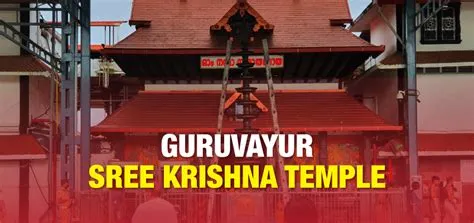Discover the untold history of Guruvayur Temple, its divine legends, myths, rituals, and significance. Learn about Lord Guruvayurappan, temple architecture, darshan timings, festivals, and travel tips for an enriching pilgrimage experience.

Nestled in the heart of Kerala, the Guruvayur Temple stands as a beacon of devotion and spirituality, attracting millions of pilgrims annually. Dedicated to Lord Krishna, revered here as Guruvayurappan, the temple’s rich tapestry of legends and myths intertwines with its historical evolution, offering a profound glimpse into its sanctity and cultural significance.
Table of Contents
Origins of the Divine Idol
The genesis of the Guruvayur Temple is steeped in celestial lore. According to ancient scriptures, the idol enshrined within the temple was originally worshipped by Lord Vishnu in Vaikuntha, his divine abode. This sacred idol was subsequently handed down to Lord Brahma, the creator, who in turn bestowed it upon the devout couple, Sutapas and Prashni. Their unwavering penance pleased Vishnu, leading him to grant their wish to parent him in three successive incarnations: as Prsnigarbha in the Satya Yuga, Vamana in the Treta Yuga, and Krishna in the Dvapara Yuga. In each of these lifetimes, the couple ardently worshipped the same idol, underscoring its divine significance.
In his incarnation as Krishna, the deity cherished the idol in his city, Dwaraka. Foreseeing the submergence of Dwaraka, Krishna entrusted his devoted friend, Uddhava, with the mission to safeguard the idol. Following Krishna’s departure from the mortal realm, a catastrophic deluge engulfed Dwaraka. Amidst this turmoil, the celestial sage Brihaspati (Guru) and the wind god Vayu retrieved the idol, embarking on a quest to find a sanctified location for its consecration.
The Sacred Installation at Guruvayur
Their journey led them to a serene lake in Kerala, where they encountered Lord Shiva and Goddess Parvati engaged in a divine dance. Recognizing the sanctity of the locale, Shiva revealed that he had been awaiting their arrival and that this very spot was destined for the idol’s enshrinement. In honor of the deities involved—Guru (Brihaspati) and Vayu—the place was christened ‘Guruvayur,’ and the presiding deity became known as ‘Guruvayurappan,’ symbolizing the Lord of Guruvayur. This divine collaboration underscores the temple’s esteemed status as ‘Bhooloka Vaikuntha,’ or heaven on earth.
Historical Evolution Through the Ages
The temple’s documented history traces back to the 14th century, with references to a place named “Kuruvayur” in the Tamil literary work “Kokasandesam.” By the 16th century, Guruvayur had emerged as a prominent pilgrimage center in Kerala. The temple’s resilience was tested during the colonial era; in 1716, Dutch invaders looted its treasures and set fire to the western gopuram (gateway), which was later reconstructed in 1747. The 18th century witnessed further turmoil when Hyder Ali and his son Tipu Sultan invaded the region. Despite these challenges, the temple withstood desecration, and the idol, which had been hidden for protection, was ceremoniously reinstalled in 1792.
A significant event in the temple’s modern history occurred on November 30, 1970, when a devastating fire engulfed the premises, destroying the chuttambalam (outer enclosure) and parts of the vilakkumatam (the structure adorned with lamps). Remarkably, the sanctum sanctorum and the deity remained unscathed, a testament, devotees believe, to divine intervention. The temple was subsequently restored to its former glory, preserving its architectural splendor and spiritual ambiance.
Legends Enriching the Temple’s Mystique
Beyond its historical chronicles, the Guruvayur Temple is enveloped in myriad legends that accentuate its spiritual allure:
- The Devotion of Nenmini Unni: A young priest named Unni, left in charge of offering nivedyam (food offering) to the deity, was disheartened when the idol did not consume the offering. In his earnestness, he wept, prompting the deity to miraculously partake in the meal, showcasing the profound bond between devotee and divinity.
- Poonthanam and Melpathur: Poonthanam, a humble devotee, sought the esteemed scholar Melpathur Narayana Bhattathiri to review his Malayalam work, ‘Jnanappana.’ Melpathur’s initial dismissal was met with divine rebuke, as Lord Guruvayurappan expressed preference for Poonthanam’s sincere devotion over scholarly pride, highlighting the supremacy of heartfelt devotion.
- Manaveda’s Vision: King Manaveda yearned for a vision of Lord Krishna. With the guidance of the sage Vilwamangalam, he witnessed the divine child playing near an Elanji tree. Overcome with emotion, the king rushed to embrace the child, who vanished, leaving behind a peacock feather. This inspired the creation of ‘Krishnanattam,’ a dance-drama depicting Krishna’s life, which continues to be performed at the temple.
Architectural Grandeur and Cultural Significance
The Guruvayur Temple exemplifies traditional Kerala architecture, characterized by its tiered roofs, intricate woodwork, and exquisite murals depicting scenes from Hindu epics. The temple complex houses several key structures:
- Sanctum Sanctorum (Sreekovil): The innermost chamber enshrining the deity, accessible only to priests.
- Nalambalam: The inner courtyard surrounding the sanctum, facilitating circumambulation by devotees.
- Chuttambalam: The outer enclosure featuring the vilakkumatam, adorned with oil lamps that illuminate the temple during rituals.
- Gopurams: The monumental gateways, with the eastern gopuram being particularly significant for its historical inscriptions.
Culturally, the temple serves as a vibrant hub of classical art, music, and dance, with the Krishnanattam dance-drama being an iconic representation of its heritage. This traditional performance, inspired by the Bhagavata Purana, narrates the life of Lord Krishna and remains an integral part of the temple’s ritualistic offerings.
Famous Devotees and Their Contributions
The Guruvayur Temple has been a sanctuary of devotion for many renowned saints, poets, and scholars throughout history. Some of the most celebrated figures associated with the temple include:
- Vilwamangalam Swamiyar: A revered saint who is believed to have had divine visions of Lord Krishna as a playful child in the temple precincts.
- Poonthanam Namboothiri: The author of Jnanappana, a revered Malayalam devotional poem emphasizing bhakti (devotion) over scholarly knowledge.
- Melpathur Narayana Bhattathiri: The celebrated Sanskrit scholar who composed Narayaneeyam, a concise retelling of the Bhagavata Purana that is now recited as a spiritual offering in the temple.
These great devotees and scholars have enriched Guruvayur’s spiritual significance, making it a center for learning, devotion, and self-realization.
The Role of Elephants in Guruvayur Temple
Guruvayur is synonymous with elephants, and its association with these majestic creatures is deeply spiritual. The Punnathur Kotta Elephant Sanctuary, located just a few kilometers from the temple, houses over 50 elephants offered to Lord Guruvayurappan by devotees. These elephants play a crucial role in daily temple rituals, processions, and festivals.
One of the most revered elephants in the temple’s history was Guruvayur Kesavan, who served the temple for over 54 years. Known for his discipline, devotion, and humility, he was posthumously honored with a statue within the temple complex, and his birthday (on Rohini Nakshatra) is still celebrated annually as Gajapooja.
Major Festivals and Celebrations at Guruvayur Temple
The temple is a focal point for several grand festivals, which attract millions of devotees. Some of the most significant include:
- Guruvayur Ekadasi – Considered the most auspicious day for Lord Krishna’s devotees, this festival marks the day of the Pandava king Bhima’s fast and is observed with special prayers, processions, and bhajans.
- Vishu Kani – Celebrated during the Malayalam New Year, Vishu is observed with elaborate flower arrangements, prayers, and early morning darshan of Guruvayurappan.
- Ashtami Rohini – The temple’s grandest Krishna Janmashtami celebration, featuring devotional songs, readings from the Bhagavata Purana, and cultural performances.
- Mandala Pooja & Makaravilakku – Observed during the Sabarimala pilgrimage season, this festival attracts thousands of Ayyappa devotees who visit Guruvayur before proceeding to Sabarimala.
Each of these festivals enhances the temple’s spiritual and cultural vibrancy, making it a must-visit for devotees and tourists alike.
How to Visit Guruvayur Temple – A Practical Guide
For those planning a visit, here’s a quick guide to ensure a smooth and fulfilling experience:
1. Travel Options
- By Air: The nearest airport is Cochin International Airport (COK), about 80 km away.
- By Train: Guruvayur Railway Station (GUV) is well-connected to major cities in Kerala and Tamil Nadu.
- By Road: Regular buses and taxis are available from cities like Thrissur, Kochi, and Bangalore.
2. Temple Darshan Timings
| Ritual | Timing |
|---|---|
| Nirmalyam | 3:00 AM |
| Usha Pooja | 6:00 AM |
| Seeveli | 7:00 AM |
| Ucha Pooja | 11:30 AM |
| Deeparadhana | 6:00 PM |
| Athazha Pooja | 8:30 PM |
| Tripuka & Temple Closure | 9:15 PM |
(Timings are subject to change during festivals and special occasions)
3. Dress Code for Devotees
- Men: White mundu/dhoti (no shirts allowed inside sanctum)
- Women: Sarees, salwar kameez, or long skirts (no Western attire)
4. Accommodation Near Guruvayur Temple
- Luxury: Krishna Inn, Hotel Devaragam
- Mid-Range: Srivar Hotels, Govind Regency
- Budget: Devaswom Guest Houses, Sreevalsam Guest House
5. Must-Visit Attractions Near Guruvayur
Apart from the Guruvayur Temple, here are some notable places nearby:
- Mammiyur Shiva Temple – A visit here is considered mandatory after Guruvayur darshan.
- Punnathur Kotta Elephant Sanctuary – Home to the temple’s ritual elephants.
- Chavakkad Beach – A serene coastal getaway just 5 km from the temple.
- Thrissur Pooram Festival – If visiting in April-May, experience Kerala’s grandest temple festival at Vadakkunnathan Temple.
The Guruvayur Temple is not just a place of worship; it is an embodiment of history, devotion, and spirituality. Whether it’s the divine idol’s ancient origins, the legends of Lord Krishna’s miracles, or the temple’s role in Kerala’s cultural fabric, Guruvayur stands as a timeless symbol of faith.
For those seeking spiritual fulfillment, a visit to Guruvayur is more than just a pilgrimage—it’s a sacred journey into the heart of devotion.
Author:
Dr. Lakshmi Narayana Sharma
Expert in Hindu Theology and Temple Rituals
📧 Email: [email protected]
